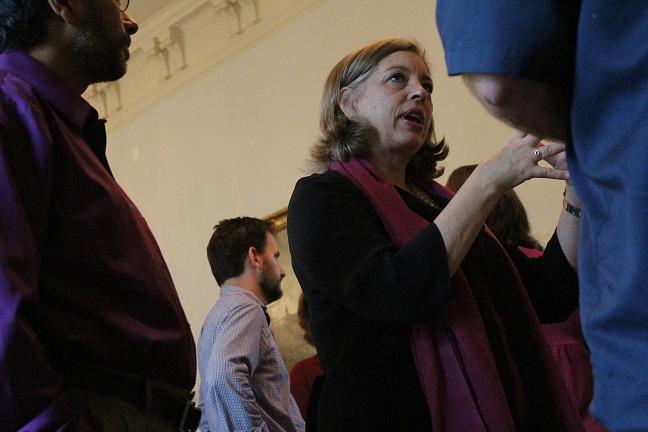Bucks President Stephanie Shanblatt faces many challenges after replacing James Linksz this
October, yet none may be greater than softening the burden students will face with mounting tuition costs.
“She’ll have to earn her spurs in a time she’s getting bludgeoned financially,” said Jack Ready,
associate economics professor at Bucks.
Student tuition now makes up approximately 52 percent of the revenue collected for the college’s operating costs, placing a heavy strain on young adults who usually work full or part-time jobs to
keep afloat, he said.
Ready was quick to point out that many of his students, full and part-time, work between 30 to 40 hours weekly to keep up with tuition and other fees.
A tuition increase of 7.8 percent will also hit students this fall, bringing the total to $3,648for one year’s full- time tuition and fees, according to phillyburbs.com. Full-time students are
defined as those taking 24 credits per year, or 12 credits per semester.
Ready emphasized that seeking funding to help alleviate pressure on students should be the new president’s biggest concern and that the college cannot continue to “keep dumping it all on students.”
“She needs to come up with outside the box ideas (to help fund the college). What are the alternative ways to do more with less,” he said.
Shanblatt must find ways to convince local and state officials to invest in the college’s future, he said. “Can she assert enough political power to find these funds from the county?”
Currently the state contributes between 26 to 28 percent to the college, with the county only able to kick in about 12 to 14 percent, according to Ready.
The basic funding model for Pennsylvania community colleges consists of one-third
contributions from students, county and state governments. Yet, due to the national economic downturn both levels of government have tightened their belts due to a lack of tax revenue.
With less tax revenue collected by the county there is less money available to fund the college. The county just can’t afford to contribute as much as it has in the past.
Enrollment numbers have also remained stagnant the last two fall semesters, with just over 10,700 registered students, in comparison to the nearly 11,300 students who registered for the fall semesters of 2009 and 2010, according to John Strauss, president of Bucks’ Federation of Teachers, using statistics from the college’s archives.
Ready credits some of the enrollment drop to modular classes, eight to 10 week courses which begin after the regular fall and spring semesters, which don’t always account for full and part-time students.
One of the more eye-popping statistics may be the drop in the number of full-time students and
the corresponding increase in part-time students. Although varying between fall and spring
semesters, Bucks has seen a significant drop with 1,200 fewer full-time students registered for the fall 2012 semester compared to four years ago.
On the flip side the college has seen an increase of nearly 700 more part-time students registered this fall compared to fall 2009. With students in a financial bind, some have been forced to cut back on education and put in more time at work, according to Ready
As recently as 2010, about 40 percent of full-time and 73 percent of part-time college students in the U.S. ages 16 to 24 were employed, according to the Institute of Education Science’s website.
This growing trend may be attributed to the increase in tuition and fees, according to Ready.
An increasing problem facing colleges nationwide has been the steady decline in the number of high school graduates, which in turn has had an adverse effect on colleges. High schools have
turned out fewer college applicants the last four years, with predictions of further declines for the next three years, according to Ready.
Another issue affecting the students indirectly is the faculty’s reaction to how Shanblatt will include them in decisions regarding the college’s future. The faculty did not always see eye-to-eye with Linksz and the college’s board of trustees, according to Ready.
In the first two years of Linksz’ presidency at Bucks, the faculty voted no confidence in his competence due to his unwillingness to share the responsibility of governing the college.
A vote by faculty nearly four years later was rejected, essentially cementing the no confidence ruling throughout Linksz’ 20-year tenure at the college.
“How can she restore a working relationship with faculty that has been strained for years? She
has to take initiative and be receptive (to get faculty involved in decision making),” he said.
Shanblatt is also facing a change not only in demographics, but in what manner these students will be educated. As the number of traditional 18 to 24-year-old students continues to dwindle, the college must adapt to students in their late-20s and older students returning to further their education for re-employment.
This may lead to a larger emphasis on distance learning classes, which in the long run may help make the college not only more attractive but more cost efficient, according to Ready.
“I would imagine this is both an exciting and challenging time to be a community college president,” said William Pezza, a social and behavioral science professor at Bucks, who listed two of Shanblatt’s major challenges.
“(She must) continue to offer a quality and affordable program in one of the most respected community colleges in the state in the face of ever –tightening government subsidies, and to
meet the expanding need of job skills programs that will train students to compete in the modern workforce,” he said.
Unanimously selected in July by Bucks’ board of trustees as the heir to Linksz, Shanblatt becomes Bucks’ first female president. She had previously worked as provost at Lansing Community College in Michigan for the past 13 years before becoming the fourth president in Bucks’ 47-year history.
“Change is a healthy thing, and I’m sure Dr. Shanblatt is anxious to put her positive imprint on an already successful program,” Pezza said.


